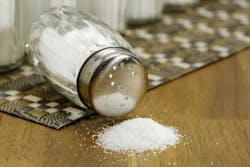About the author: For more information, contact Mark Gross, Ph.D., training manager for Orenco Systems, Inc., at 800.348.9843, or by e-mail at [email protected].
Updated 10/12/21
Water Quality Products recently spoke with Mark Gross, Ph.D., training manager for Orenco Systems, Inc., Sutherlin, Ore., and asked him to address issues regarding the effects of water softener discharges on onsite wastewater systems. Orenco designs and manufactures advanced onsite(decentralized) wastewater technologies for individual properties and small communities.
WQP: Could you please sum up the debate surrounding water softeners discharging into septic systems?
Mark Gross: The issue is whether or not the salty backwash brine from water softeners is harmful to the wastewater treatment system. There is no debate whatsoever that softened water is a good thing. We’re really high on using water softeners to soften household water, but we do not want the salty backwash brine from the water softener regenerate to go into the wastewater system. That’s the problem—the backwash brine affects the wastewater system in a negative way.
WQP: What are the negative effects of the backwash brine discharging into septic systems?
Gross: Saltwater is more dense than freshwater, so when it’s flushed into the septic tank, the saltwater goes to the bottom of the tank and can displace the sludge that is supposed to settle in the septic tank—like a clarifier. When the sludge is displaced, it can wash out of the septic tank, so it’s like having sludge washout in a clarifier: it affects all of the downstream processes. If it goes to a drain field, the sludge will wash directly into the drainfield and plug it up. If it goes from the septic tank to an advanced treatment process, the treatment process is not designed to deal with partially digested sludge.
WQP: What do you think is the best solution to preventing the harm caused by water softeners?
Gross: We met with the Water Quality Association (WQA), which is the representative for the water softener industry, and we are in agreement with the WQA on the solution. We agreed that a great alternative is to have a separate pipe laid alongside the house sewer pipe, around the treatment system and into the drain field when a house is built. The backwash brine could be plumbed into that pipe. It’s a really inexpensive solution if you’re already laying a pipe in the trench. It’s not even expensive to modify and reroute a brine discharge away from the wastewater system after the fact.
WQP: What about for houses that are already built?
Gross: Dealers would have to check with the local regulatory agency on where they could discharge the brine. Some regulations define the brine as “mineral-laden water free of contaminates”—that way it is recognized for what it is, and thus need not be discharged to the wastewater system. Many states prohibit discharging the brine into the wastewater treatment. In some states we have simply redirected the brine backwash into a basement sump. It’s just saltwater and some calcium magnesium iron—nothing too hostile.
WQP: What evidence does Orenco have regarding the harm caused by water softeners?
Gross: We did a performance analysis of our wastewater treatment systems in Virginia. We looked at 18 sites, and each site had to be sampled and analyzed over 18 months. We have more than 5,000 data points in our analytical data set. We found that we had some systems that met all of the requirements for the National Sanitation Foundation’s Standard 40 Class 1 water quality, but they were performing poorly based on our standards.
We started investigating things that might have caused these few systems to not perform as well as the others. In most cases, the lower-performing systems had really high chlorides in the wastewater, and we know that chlorides are harmful to nitrifiers. There are a lot of research papers that have been written on activated sludge processes, so there is scientific literature that says high chloride concentrations are hard on the nitrifiers. We started looking to see where the chlorides could have been coming from, and in every case there was a water softener discharging its brine into the waste stream.
After the study was over, we rerouted those water softener brine discharges over to the sumps. Most of these were in basements or in garages—some place where we could reroute them out to discharge into the lawn or a basement drain since it was just saltwater. In several of the cases, the systems came right into good performance, and the chloride concentrations went down. They were still receiving softened water; they just weren’t receiving the brine.
WQP: Is Orenco in favor of bans on water softeners?
Gross: No, we don’t want to ban water softeners at all. We’re proponents of water softeners. We like for people to have nice soft water so that their dishes don’t have stains and so their water heaters don’t burn up because of the calcium deposits. We think softeners are a great addition for quality of life. We just don’t want the backwash brine in the waste stream. The backwash brine needs to be rerouted, not put into the septic system.
WQP: Could you tell me what came out of the meeting in May with Orenco and the WQA? Was any progress made toward a cooperative effort regarding water softeners?
Gross: I thought that was a very positive meeting. I think there was a cooperative spirit between the WQA and Orenco. We believe in water softeners, and we want the water softener people to believe in good wastewater treatment and be good stewards of the land and route their waste stream properly. We agreed that an alternative would be just to put a separate pipe in when the houses are being built. That would be a good thing for state regulators to add to their prescriptive wastewater code.
WQP: What do you think can be done to get regulators aware of the issue?
Gross: Publications like this will really help.
Download: Here
